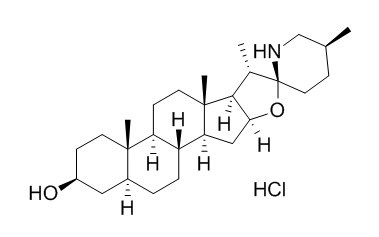Home
Products
Tomatidine hydrochloride



| Product Name | Tomatidine hydrochloride |
| Price: | $92 / 10mg |
| Catalog No.: | CN01072 |
| CAS No.: | 6192-62-7 |
| Molecular Formula: | C27H46ClNO2 |
| Molecular Weight: | 452.11 g/mol |
| Purity: | >=98% |
| Type of Compound: | Alkaloids |
| Physical Desc.: | Powder |
| Source: | The fruits of Lycopersicon esculentum Mill. |
| Solvent: | Chloroform, Dichloromethane, Ethyl Acetate, DMSO, Acetone, etc. |
| SMILES: | CC1CCC2(NC1)OC1C(C2C)C2(C(C1)C1CCC3C(C1CC2)(C)CCC(C3)O)C.Cl |
| Contact us | |
|---|---|
| First Name: | |
| Last Name: | |
| E-mail: | |
| Question: | |
| Description | Tomatidine hydrochloride acts as an anti-inflammatory agent by blocking NF-κB and JNK signaling. |
| Target | p65 JNK |
| In Vitro | Tomatidine decreases inducible NO synthase and COX-2 expression through suppression of I-κBα phosphorylation, NF-κB nuclear translocation and JNK activation, which in turn inhibits c-jun phosphorylation and Oct-2 expression. Tomatidine, solasodine and diosgenin (40 μM) show 66%, 22% and 41% inhibition of nitrite production, respectively. The iNOS protein is barely detectable in unstimulated cells but markedly increases after LPS treatment, and Tomatidine causes dose-dependent inhibition of LPS-induced iNOS expression. p65 is the major component of NF-κB in LPS-stimulated macrophages, the effect of Tomatidine on p65 DNA-binding activity is determined. In the presence of Tomatidine at 10-40 μM, the binding activity of NF-κB is suppressed in a dose-dependent manner. Tomatidine inhibits the phosphorylation of I-κB, blocks the I-κB production, and furthermore suppresses p65 NF-κB translocation to the nucleus and modulated binding activity[1]. |
| Cell Assay | RAW 264.7 cells, derived from murine macrophages, are cultured in DMEM supplemented with 10% endotoxin-free, heat-inactivated fetal calf serum, Penicillin (100 units/mL), and Streptomycin (100 μg/mL) in a 5% CO2 atmosphere at 37 °C in a humidified incubator. For all assay, cell is plated at 2×105 cells/cm2 in culture dishes or plates. Treatment with vehicle (0.1% DMSO or 0.1% ethanol), test compounds and/or LPS is carried out under serum-free conditions[1]. |
| Boiling Point | 551.1ºC at 760 mmHg |
| Flash Point | 287.1ºC |
| Exact Mass | 451.321716 |
| PSA | 41.49000 |
| LogP | 6.49760 |
| Storage condition | -20℃ |